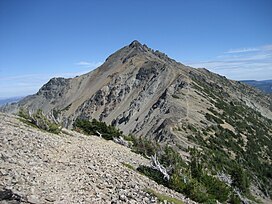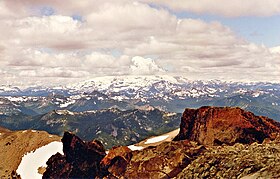| Mount Aix | |
|---|---|
 Mount Aix, northwest aspect | |
| Highest point | |
| Elevation | 7,766 ft (2,367 m)[1] |
| Prominence | 3,296 ft (1,005 m)[1] |
| Parent peak | Old Snowy Mountain[2] |
| Isolation | 20.67 mi (33.27 km)[2] |
| Coordinates | 46°47′42″N 121°15′21″W / 46.7950218°N 121.2558375°W[3] |
| Geography | |
| Country | United States |
| State | Washington |
| County | Yakima |
| Protected area | William O. Douglas Wilderness |
| Parent range | Cascades |
| Topo map | USGS Bumping Lake |
| Geology | |
| Mountain type | Stratovolcano, volcanic complex |
| Climbing | |
| Easiest route | Trail class 1 |
Mount Aix is a 7,766-foot (2,367 m) mountain summit in Yakima County of Washington state.
Description[edit]
Mount Aix is set in the William O. Douglas Wilderness on land administered by the Wenatchee National Forest and is the highest point in the wilderness area.[1] Mount Aix is situated east of the crest of the Cascade Range, southeast of Bumping Lake, north of Bismarck Peak, and northwest of Rimrock Lake. It is also 24 miles east-southeast of Mount Rainier. The nearest higher peak is Tieton Peak in the Goat Rocks Wilderness, 19.9 mi (32.0 km) to the south-southwest.[1] Mount Aix is the highest peak in the entire region which is east of Mount Rainier National Park, north of Goat Rocks Wilderness, west of Yakima, and south of Mount Daniel (Alpine Lakes Wilderness), so it is quite prominent. Prior to 1897 (when Mount Aix was officially recognized by the USGS) the toponym was spelled as Mount Aiks on early survey maps[3] and publications.[4]

Climate[edit]
Mount Aix is located east of the Cascade crest. Most weather fronts originating in the Pacific Ocean travel northeast toward the Cascade Mountains. As fronts approach, they are forced upward by the peaks of the Cascade Range (orographic lift), causing them to drop their moisture in the form of rain or snow onto the Cascades. As a result, the east side of the Cascades experiences less precipitation than the west side of the crest. During winter months, weather is usually cloudy, but due to high pressure systems over the Pacific Ocean that intensify during summer months, there is often little or no cloud cover during the summer.[5] Precipitation runoff from Mount Aix drains into tributaries of the Yakima River, thence into the Columbia River.
Geology[edit]
Mount Aix is a volcanic complex, mostly referred to as the Mount Aix Volcanic Complex.
See also[edit]
References[edit]
- ^ a b c d "Mount Aix, Washington". Peakbagger.com. Retrieved 22 July 2020.
- ^ a b "Aix, Mount - 7,766' WA". listsofjohn.com. Retrieved 2023-09-26.
- ^ a b "Mount Aix". Geographic Names Information System. United States Geological Survey, United States Department of the Interior.
- ^ Case, O. D. (1876). The United States: Historical, Descriptive, and Statistical: With an Alphabetical Index to Counties, Mountains, Lakes, Rivers, &o. O.D. Case and Company, Chicago. p. 93.
- ^ Beckey, Fred W. Cascade Alpine Guide, Climbing and High Routes. Seattle, WA: Mountaineers Books, 2008.
External links[edit]
- Weather forecast: Mount Aix
- National Forest Service web site: William O Douglas Wilderness
- Washington Trails Association web site: Mount Aix Trail
- National Geodetic Survey data sheet


Well, that’s interesting to know that Psilotum nudum are known as whisk ferns. Psilotum nudum is the commoner species of the two. While the P. flaccidum is a rare species and is found in the tropical islands. Both the species are usually epiphytic in habit and grow upon tree ferns. These species may also be terrestrial and grow in humus or in the crevices of the rocks.
View the detailed Guide of Psilotum nudum: Detailed Study Of Psilotum Nudum (Whisk Fern), Classification, Anatomy, Reproduction